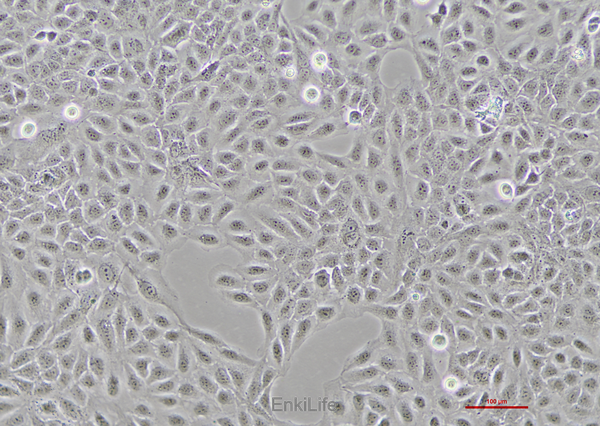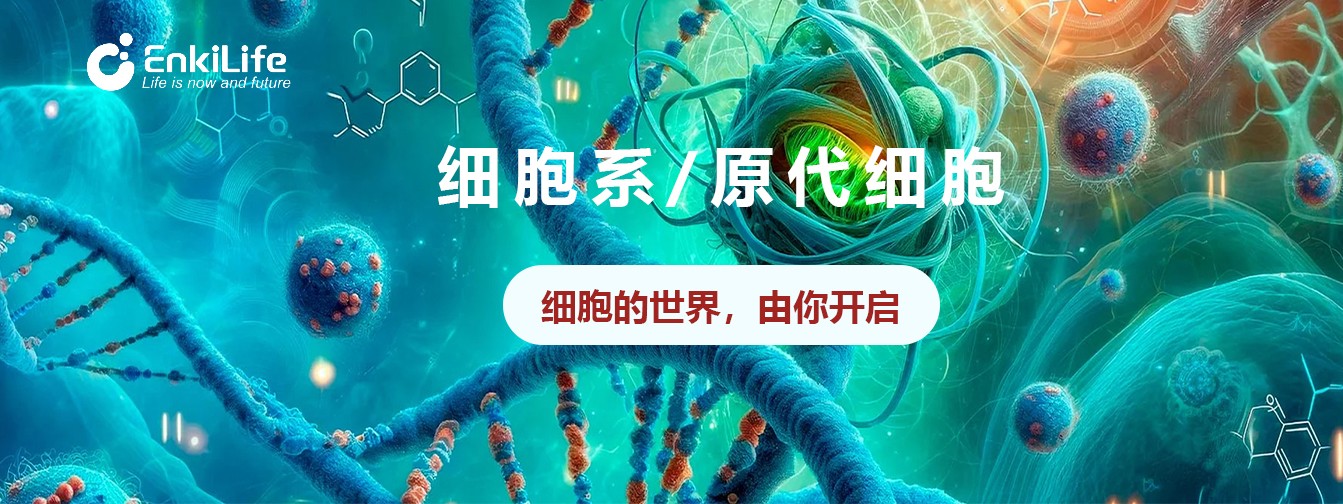人骨肉瘤细胞系U2OS
发表时间:2025-07-16人骨肉瘤细胞系U2OS
一. 细胞起源
1.起源:U2OS细胞系于1964年从一名15岁女性患者的胫骨近端中分化骨肉瘤中分离建立,属于成骨细胞来源的恶性肿瘤细胞[1]。
2.特性:保留成骨细胞分化潜能,可表达碱性磷酸酶(ALP)和骨钙素(OCN)等成骨标志物[2]。

二. 生物学特性
1.增殖与凋亡调控:
- 促增殖因子:TRIM59过表达通过激活Rb/E2F通路显著促进增殖(siRNA敲低后增殖抑制60-70%)[3];p38γ过表达增强Cyclin E1/A表达,加速细胞周期进程[4]。
- 凋亡敏感机制:野生型p53状态使其对DNA损伤剂(如阿霉素)敏感,IFN-α通过p53/Bax通路增强凋亡[5];姜黄素纳米粒(Cur-NPs)通过抑制Akt磷酸化诱导线粒体凋亡[6]。
2.侵袭转移特性:
- hTERT过表达通过增强细胞外基质黏附能力促进侵袭[7]。
- COX-2过表达上调MMP-2/9活性,加速迁移与侵袭(可被NS-398抑制剂逆转)[8]。
3.分子标志物:
- miRNA调控:miR-150低表达(靶向ZEB1)及miR-192低表达(靶向TCF7)均与侵袭性正相关[9][10]。
- 分化相关基因:NDRG1/Cap43高表达促进成骨分化,抑制其表达则增强增殖[2]。
三. 培养与储存
1.培养条件:DMEM培养基(含10%胎牛血清),37°C、5% CO?环境,贴壁生长[1]。
2.冻存方法:90% FBS + 10% DMSO,液氮长期保存,复苏存活率>80%[1]。
四. 研究应用领域
1.药物筛选平台:广泛用于化疗药物(如阿霉素[5])、天然化合物(如Polyphyllin VI[10]、Hyperoside[11])的抗肿瘤机制研究。
2.基因功能研究:通过siRNA/质粒转染验证TRIM59[9]、p38γ[4]等基因的致癌作用。
3.凋亡与自噬机制:Polyphyllin VI通过ROS/JNK通路诱导凋亡与自噬[12]。
五. 近五年研究进展(2020–2025)
1.靶向治疗新策略:
- p38γ基因敲除(CRISPR/Cas9)显著抑制体内肿瘤生长[4]。
- Polyphyllin VI通过G2/M期阻滞及ROS/JNK通路抑制肿瘤[12]。
2.表观遗传调控:miR-192模拟物通过抑制TCF7降低侵袭性[10]。
3.纳米药物递送:PLGA封装姜黄素纳米粒(Cur-NPs)增强凋亡效应[6]。
六. 局限性与克服策略
1.局限性:
- 缺乏肿瘤微环境模拟,难以反映体内免疫互作[1]。
- 部分分子机制存在矛盾(如p53在凋亡中兼具促生存与促死亡作用)[5][13]。
2.克服方法:
- 3D培养与类器官模型构建[1]。
- 联合多组学分析(如单细胞测序)解析异质性[4]。
七. 总结与展望
U2OS细胞系作为骨肉瘤研究的核心模型,在揭示增殖-分化平衡、转移机制及药物响应中发挥不可替代作用。未来需聚焦:
1.精准靶向:基于CRISPR筛选鉴定新靶点(如TRIM59[9]、p38γ[4])。
2.联合治疗:免疫检查点抑制剂与化疗/靶向药联用(借鉴IFN-α增敏研究[5])。
3.临床转化:推动天然化合物(如Polyphyllin VI[12])的临床试验。

参考文献
1. Zou CY, et al. Establishment and characteristics of two syngeneic human osteosarcoma cell lines from primary tumor and skip metastases. Cancer Cell Int. 2008;8:7. PMID: 18423048.
2. Matsugaki T, et al. N-myc downstream-regulated gene 1/Cap43 expression promotes cell differentiation of human osteosarcoma cells. J Cancer Res Clin Oncol. 2010;136(9):1263-1262. PMID: 20157723.
3. Liang J, et al. TRIM59 is upregulated and promotes cell proliferation and migration in human osteosarcoma. Am J Cancer Res. 2016;6(6):1177-1190. PMID: 27429838.
4.Shi C, et al. p38γ overexpression promotes osteosarcoma cell progression. Cancer Manag Res. 2020;12:8987-8995. PMID: 33061576.
5.Yuan XW, et al. Interferon-α enhances sensitivity of human osteosarcoma U2OS cells to doxorubicin by p53-dependent apoptosis. Acta Pharmacol Sin. 2007;28(11):1835-1841. PMID: 17971722.
6.Peng SF, et al. Curcumin-loaded nanoparticles enhance apoptotic cell death of U2OS human osteosarcoma cells through the Akt-Bad signaling pathway. Int J Oncol. 2013;44(1):238-246. PMID: 23135377.
7.Yu SD, et al. hTERT promotes the invasion of telomerase-negative tumor cells in vitro. Oncol Rep. 2009;22(2):365-371. PMID: 19578772.
8.Lee EJ, et al. Cyclooxygenase-2 promotes cell proliferation, migration and invasion in U2OS human osteosarcoma cells. Exp Mol Med. 2007;39(4):469-479. PMID: 179343310.
9.Xu J, et al. MicroRNA-150 functions as an antioncogenic regulator in osteosarcoma. Oncol Rep. 2017;38(2):759-7610. PMID: 286562811.
10.Wang Y, et al. Upregulation of miR-192 inhibits cell growth and invasion and induces cell apoptosis by targeting TCF7 in human osteosarcoma. Oncol Rep. 2016;36(5):2574-2582. PMID: 27633083.
11.Zhang N, et al. Hyperoside, a flavonoid compound, inhibits proliferation and stimulates osteogenic differentiation of human osteosarcoma cells. PLoS One. 2014;9(7):e98979. PMID: 249999810.
12.Yuan YL, et al. Polyphyllin VI induces apoptosis and autophagy in human osteosarcoma cells by modulation of ROS/JNK activation. Drug Des Devel Ther. 2019;13:3091-3103. PMID: 31686774.
13.Yan X, et al. p53 siRNA inhibits apoptosis of U2OS cells treated with azurin. Oncol Lett. 2011;2(5):811-817. PMID: 22870138.




